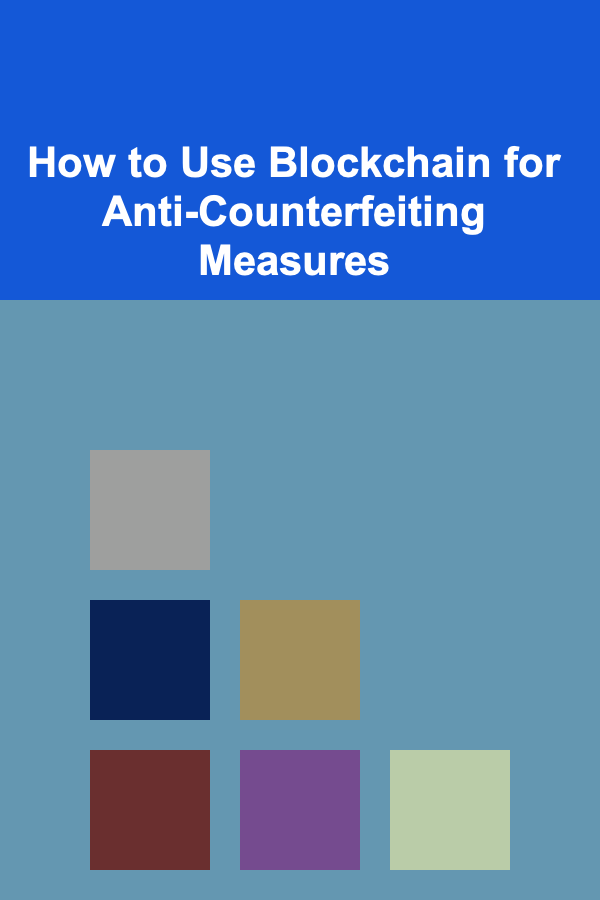
How to Use Blockchain for Anti-Counterfeiting Measures
ebook include PDF & Audio bundle (Micro Guide)
$12.99$7.99
Limited Time Offer! Order within the next:

Counterfeiting has become one of the most significant issues facing global industries today. From fake luxury goods to counterfeit pharmaceuticals, the impact of counterfeit products on the economy, public health, and consumer trust cannot be overstated. As the world becomes increasingly digital, so too does the sophistication of counterfeiters. Traditional anti-counterfeiting measures, such as physical security labels, holograms, or barcodes, have proven to be insufficient, and often fail to prevent the proliferation of counterfeit goods in the market.
In recent years, blockchain technology has emerged as a powerful tool for combating counterfeiting. Blockchain's decentralized and immutable nature makes it an ideal candidate for verifying the authenticity of products, tracking their journey through supply chains, and ensuring that they meet industry standards. This article delves into how blockchain can be used as a solution for anti-counterfeiting measures and the potential it holds in transforming the way we fight counterfeit goods.
Understanding Counterfeiting and Its Impacts
Before delving into blockchain's role in anti-counterfeiting measures, it is essential to understand the full scope of counterfeiting and its impacts. Counterfeiting refers to the illegal replication of products, typically with the intent to deceive consumers into purchasing fake or substandard goods. These counterfeit items are often sold at a lower price, undermining the reputation of genuine brands and putting consumers at risk.
Counterfeiting affects virtually every industry, including:
- Luxury goods: Fake high-end brands like Louis Vuitton or Rolex often flood the market, damaging brand reputation and consumer trust.
- Pharmaceuticals: Counterfeit medicines pose severe risks to public health, as they may be ineffective, harmful, or dangerous.
- Electronics: Counterfeit electronic components can cause system malfunctions or even pose safety hazards, such as fires or electrocution.
- Food and beverages: Fake food products may not only be harmful to health but can also damage the integrity of brands.
The consequences of counterfeiting extend beyond the immediate financial loss for companies. It leads to loss of consumer confidence, increased regulation and oversight, legal battles, and public health crises. Traditional methods of combating counterfeiting, such as marking products with barcodes, RFID tags, or security seals, often fall short. These measures can be easily tampered with or replicated, leaving them vulnerable to sophisticated counterfeiters.
Blockchain: A Game-Changer for Anti-Counterfeiting
Blockchain is a decentralized, distributed ledger technology that enables secure, transparent, and immutable record-keeping. Each transaction or data entry is stored in blocks that are linked in chronological order, forming a chain. These blocks are secured using cryptographic algorithms, making it nearly impossible to alter or manipulate the data once it has been recorded.
At its core, blockchain offers three key features that make it an effective tool in the fight against counterfeiting:
1. Transparency and Traceability
Blockchain provides a transparent and immutable record of all transactions. When applied to anti-counterfeiting, it allows every product's lifecycle to be tracked from the manufacturer to the consumer. This traceability ensures that every transaction, including the sourcing of raw materials, the manufacturing process, distribution, and even retail, is recorded on the blockchain.
In industries like pharmaceuticals or luxury goods, this transparency ensures that counterfeiters cannot tamper with the product's origins or history. Blockchain technology enables stakeholders---manufacturers, suppliers, distributors, retailers, and consumers---to verify the authenticity of a product at any stage of its journey.
For example, a consumer purchasing a luxury watch can scan a QR code or use a blockchain-powered app to verify whether the watch is authentic by checking its entire production and distribution history. This traceability effectively eliminates the possibility of counterfeit products entering the supply chain.
2. Immutability and Security
Blockchain's immutability feature ensures that once data is recorded on the blockchain, it cannot be altered, deleted, or forged. This is a significant advantage when it comes to ensuring product authenticity. Each product's journey, from the manufacturing process to its arrival in the consumer's hands, is recorded in a way that is both transparent and permanent.
For example, in the case of pharmaceuticals, counterfeit drugs can be traced back to their origins, and any attempts to alter their records would be immediately apparent. The immutable nature of blockchain makes it nearly impossible for counterfeiters to falsify a product's origin or manufacturing details without detection.
Furthermore, blockchain's security ensures that product information cannot be tampered with. All records are cryptographically secured, and only authorized parties can add or update information. This high level of security makes it extremely difficult for counterfeiters to forge product histories or alter the data.
3. Decentralization and Trust
Blockchain operates on a decentralized network of computers (nodes), meaning there is no central authority controlling the data. This decentralization creates a trustless environment where participants do not need to rely on a third-party intermediary to verify the authenticity of a product. Instead, the trust comes from the consensus mechanism used by the blockchain network.
In a blockchain-powered anti-counterfeiting system, the distributed nature of the network means that no single party has control over the data. This eliminates the possibility of a single point of failure or manipulation. The network participants (manufacturers, suppliers, distributors, and consumers) can independently verify the product's authenticity and ensure that it has not been tampered with.
How Blockchain Can Be Used for Anti-Counterfeiting
There are several ways blockchain can be implemented for anti-counterfeiting purposes. Here are a few examples of how different industries can leverage blockchain to combat counterfeiting:
1. Luxury Goods and Fashion
Luxury goods manufacturers, such as those producing designer handbags, watches, or jewelry, are frequently targeted by counterfeiters. Blockchain can be used to create an immutable, verifiable record for each item produced. By embedding blockchain-powered digital certificates or QR codes on each product, consumers can scan the code to verify the authenticity of the item.
For instance, a blockchain solution could be implemented in the form of a unique digital certificate attached to a luxury product, such as a handbag. Every time the handbag changes hands---whether it is sold by a retailer or transferred to a second-hand buyer---the transaction is recorded on the blockchain. This ensures that the item's provenance is always verifiable and transparent.
2. Pharmaceuticals and Healthcare
The pharmaceutical industry is particularly vulnerable to counterfeiting, with fake drugs causing serious harm to public health. Blockchain technology can be used to create a transparent supply chain for pharmaceuticals, ensuring that drugs are traced from the manufacturer to the pharmacy or hospital where they are distributed.
By implementing blockchain for anti-counterfeiting, pharmaceutical companies can ensure that every pill, vial, or vaccine has a verifiable history. When a drug is manufactured, its details, including batch number, production date, and expiry date, are recorded on the blockchain. When the drug is distributed, the relevant parties (wholesalers, retailers, healthcare providers) can verify the authenticity of the product before it reaches the patient.
Additionally, patients can access a mobile application linked to the blockchain to verify that the drug they are purchasing is authentic, reducing the risk of consuming counterfeit medications.
3. Electronics and Automotive Parts
The electronics and automotive industries also suffer from counterfeiting, with counterfeit parts often causing safety issues or system failures. Blockchain can be used to track the provenance of every part in an electronic device or vehicle, ensuring that counterfeit parts do not enter the supply chain.
For example, in the case of automotive parts, each component could be tagged with a blockchain-based identification that records its origin, manufacturing process, and distribution history. When a part is installed in a vehicle, the vehicle's maintenance system could access the blockchain to verify that all parts are genuine and safe to use.
4. Food and Beverages
Counterfeit food products, whether fake ingredients or adulterated items, pose significant risks to consumers. Blockchain can be used to track the supply chain of food products, ensuring that each step of the production, processing, and distribution process is recorded and transparent.
For instance, a blockchain-based system can trace the journey of an organic apple from the farm to the supermarket. The consumer could scan a QR code on the apple's packaging to verify that it came from a certified organic farm and was processed according to industry standards.
5. Art and Collectibles
The art world has long been plagued by counterfeits, with fake paintings and sculptures often being sold at exorbitant prices. Blockchain can create a digital certificate of authenticity for every piece of art, allowing collectors to verify the provenance of a piece before making a purchase.
By embedding a blockchain record in the art piece or linking it to a unique identifier, such as a digital certificate or NFT (non-fungible token), buyers can ensure that the piece they are purchasing is genuine. This system can also help track ownership and sales history, ensuring that the art's value remains transparent.
Challenges and Considerations
While blockchain offers significant promise in the fight against counterfeiting, it is not without its challenges. Some of the main considerations include:
- Adoption and Integration: For blockchain to be effective in anti-counterfeiting, it requires widespread adoption across the entire supply chain, including manufacturers, distributors, retailers, and consumers. Integrating blockchain into existing systems may require significant investments in technology and infrastructure.
- Cost: Implementing blockchain for anti-counterfeiting measures may come with additional costs, particularly for small and medium-sized businesses. However, the long-term benefits of reducing counterfeit-related losses and protecting brand reputation may outweigh the initial investment.
- Scalability: Blockchain systems must be able to handle large volumes of transactions, especially in industries with high production volumes, such as food and electronics. Solutions like private blockchains or layer-2 protocols may be necessary to ensure scalability.
- Data Privacy: While blockchain is transparent, there may be concerns around privacy when recording sensitive information, such as production methods or pricing details. Solutions that strike a balance between transparency and data privacy will be necessary.
Conclusion
Blockchain technology has the potential to revolutionize the way industries fight counterfeiting. By providing transparency, immutability, and decentralization, blockchain can create secure and verifiable records of product authenticity, ensuring that counterfeit goods are kept out of the supply chain. While there are challenges to overcome, the benefits of using blockchain for anti-counterfeiting measures far outweigh the risks. As more industries adopt blockchain solutions, the fight against counterfeiting will become more effective, safeguarding consumers, businesses, and economies worldwide.

How to Create a Checklist for Leadership Development Programs
Read More
How to Create a Checklist for Managing Tax Liabilities
Read More
How to Get Started with a Free Home Budget App in 5 Easy Steps
Read More
The Photographer's Playbook: Techniques for Creative Photography
Read More
Interpreting Your Full Genome Sequence: A Comprehensive Guide
Read More
How to Integrate Kanban Boards into Your Project To-Do List Workflow
Read MoreOther Products

How to Create a Checklist for Leadership Development Programs
Read More
How to Create a Checklist for Managing Tax Liabilities
Read More
How to Get Started with a Free Home Budget App in 5 Easy Steps
Read More
The Photographer's Playbook: Techniques for Creative Photography
Read More
Interpreting Your Full Genome Sequence: A Comprehensive Guide
Read More